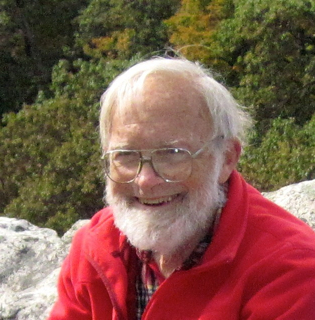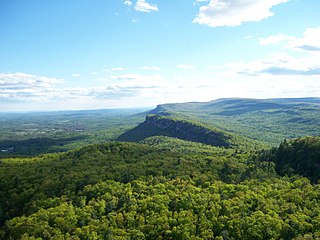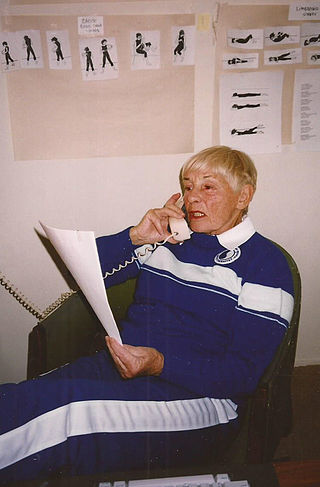
Friedrich Wolfgang Beckey, known as Fred Beckey, was an American rock climber, mountaineer and book author, who in seven decades of climbing achieved hundreds of first ascents of some of the tallest peaks and most important routes throughout Alaska, the Canadian Rockies and the Pacific Northwest. Among the Fifty Classic Climbs of North America, seven were established by Beckey, often climbing with some of the best known climbers of each generation.

William Crowther is an American computer programmer, caver, and rock climber. He is the co-creator of Colossal Cave Adventure from 1975 onward, a seminal computer game that influenced the first decade of video game design and inspired the text adventure game genre.

Carolynn Marie Hill is an American rock climber. Widely regarded as one of the leading competitive climbers, traditional climbers, sport climbers, and boulderers in the world during the late 1980s and early 1990s, she is famous for making the first free ascent of the difficult sheer rock face of The Nose on El Capitan in Yosemite Valley, and for repeating it the next year in less than 24 hours. She has been described as both one of the best female climbers in the world and one of the best climbers in the history of the sport. One of the first successful women in the sport, Hill shaped rock climbing for women and became a public spokesperson, helping it gain wider popularity and arguing for sex equality. Hill has publicized climbing by appearing on television shows and documentaries and writing an autobiography, Climbing Free: My Life in the Vertical World.
Clinton Joseph Davisson was an American physicist who won the 1937 Nobel Prize in Physics for his discovery of electron diffraction in the famous Davisson–Germer experiment. Davisson shared the Nobel Prize with George Paget Thomson, who independently discovered electron diffraction at about the same time as Davisson.

The Shawangunk Ridge, also known as the Shawangunk Mountains or The Gunks, is a ridge of bedrock in Ulster County, Sullivan County and Orange County in the state of New York, extending from the northernmost point of the border with New Jersey to the Catskills. The Shawangunk Ridge is a continuation of the long, easternmost section of the Appalachian Mountains; the ridge is known as Kittatinny Mountain in New Jersey, and as Blue Mountain as it continues through Pennsylvania. This ridge constitutes the western border of the Great Appalachian Valley.

Yvon Chouinard is an American rock climber, environmentalist, philanthropist, and outdoor industry businessman. His company, Patagonia, is known for its commitment to protecting the environment. He was named one of the 100 most influential people in the world by Time magazine in 2023.

Davisson is a lunar impact crater that is located on the far side of the Moon from the Earth. This crater lies across the eastern rim of the huge walled plain Leibnitz, and the rim and outer rampart intrudes into the interior floor of Leibnitz. To the east-northeast of Davisson is the walled plain Oppenheimer, a formation only somewhat smaller than Leibnitz.

The Davisson–Germer experiment was a 1923–1927 experiment by Clinton Davisson and Lester Germer at Western Electric, in which electrons, scattered by the surface of a crystal of nickel metal, displayed a diffraction pattern. This confirmed the hypothesis, advanced by Louis de Broglie in 1924, of wave-particle duality, and also the wave mechanics approach of the Schrödinger equation. It was an experimental milestone in the creation of quantum mechanics.

The Regular Northwest Face of Half Dome was the first Grade VI big wall climbing route in the United States. It was first climbed in 1957 by a team consisting of Royal Robbins, Mike Sherrick, and Jerry Gallwas. Its current aid climbing rating is VI 5.9 A1 or 5.12 for the free climbing variation. It is recognized in the historic climbing text Fifty Classic Climbs of North America and considered a classic around the world.

Fritz Wiessner was a German American pioneer of free climbing. Born in Dresden, Germany, he immigrated to New York City in 1929 and became a U.S. citizen in 1935. In 1939, he made one of the earliest attempts to conquer K2, one of the most difficult mountains in the world to climb.
Hans Kraus was a physician, physical therapist, mountaineer, and alpinist. A pioneer of modern rock climbing, he was also one of the fathers of sports medicine and physical medicine and rehabilitation and was elected to the U.S. National Ski Hall of Fame in 1974.

Henry Barber is an American rock climber and ice climber who rose to prominence in the 1970s. Known by the nickname "Hot Henry", Barber was an advocate of clean climbing, a prolific first ascenscionist and free soloist. He was one of the first American rock climbers to travel widely to climb in different countries, and was one of the first "professional" American rock climbers, supporting himself as a sales representative for outdoor equipment companies including Chouinard Equipment and Patagonia, and by giving lectures and slide shows. He was an integral member of the "Front Four" quartet of the 1970s: "Hot Henry", John Stannard, Steve Wunsch, and John Bragg.

Bonnie Prudden was an American physical fitness pioneer, rock climber and mountaineer. Her report to Eisenhower on the unfitness of American children as compared with their European counterparts led to the formation of the President's Council on Youth Fitness.
The Davisson–Germer Prize in Atomic or Surface Physics is an annual prize that has been awarded by the American Physical Society since 1965. The recipient is chosen for "outstanding work in atomic physics or surface physics". The prize is named after Clinton Davisson and Lester Germer, who first measured electron diffraction, and as of 2007 it is valued at $5,000.
John David Reppy is a physicist and the John L. Wetherill Professor of Physics Emeritus at Cornell University. He studies the quantum properties of superfluids such as helium.
Allen Parker Steck was an American mountaineer and rock climber.
John Bragg is an American rock climber and alpinist, noted for first ascents of difficult rock climbs in the Shawangunks and Colorado, and taking high-grade rock skills to Patagonia, to make the first ascent of Torre Egger in 1976 with Jim Donini and Jay Wilson.

In climbing and mountaineering, a traverse is a section of a climbing route where the climber moves laterally, as opposed to in an upward direction. The term has broad application, and its use can range from describing a brief section of lateral movement on a pitch of a climbing route, to large multi-pitch climbing routes that almost entirely consist of lateral movement such as girdle traverses that span the entire rock face of a crag, to mountain traverses that span entire ridges connecting chains of mountain peaks.
Poke-O-Moonshine Mountain, spelled Pokamoonshine on U.S. Geological Survey maps, and sometimes known as just Poke-O, is a minor peak of the Adirondack Mountains. The name is believed to be a corruption of the Algonquin words pohqui, meaning 'broken', and moosie, meaning 'smooth'. It is located in the town of Chesterfield, New York, United States, on New York state Forest Preserve land, part of the Taylor Pond Wild Forest complex within the Adirondack Park. Due to its location next to the pass through which most travelers from the north enter the range, it has been called the "gateway to the Adirondacks".

The 1970 British Annapurna South Face expedition was a Himalayan climb that was the first to take a deliberately difficult route up the face of an 8,000-metre mountain. On 27 May 1970 Don Whillans and Dougal Haston reached the summit of Annapurna I, which at 26,545 feet (8,091 m) is the highest peak in the Annapurna Massif in Nepal. Chris Bonington led the expedition, which approached up a glacier from the Annapurna Sanctuary and then used rock climbing techniques to put fixed ropes up the steep South Face. Although the plan had been to use supplementary oxygen, in the event it was not possible to carry any cylinders high enough for the lead climbers to use on their summit bid.














